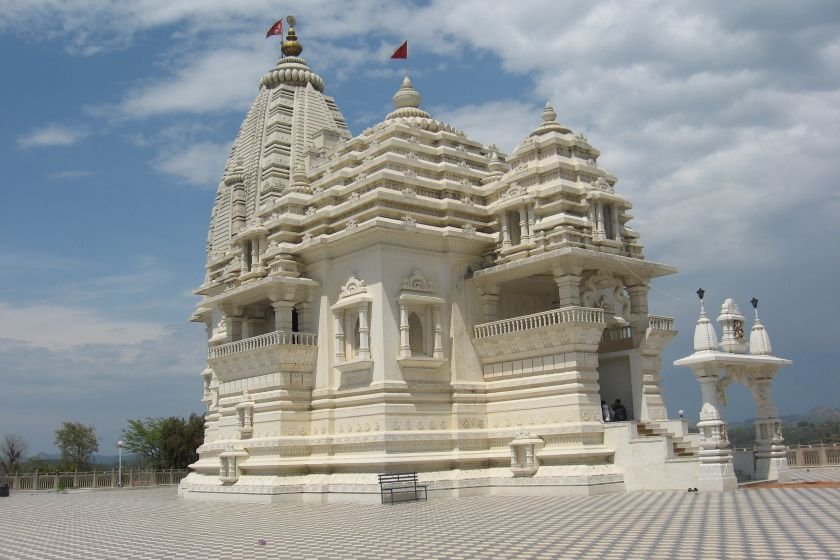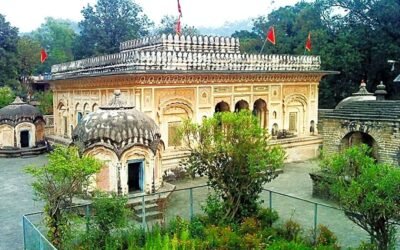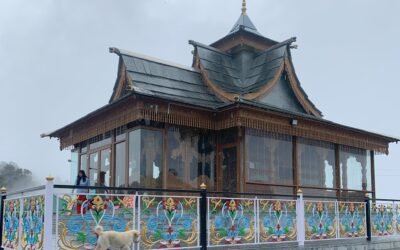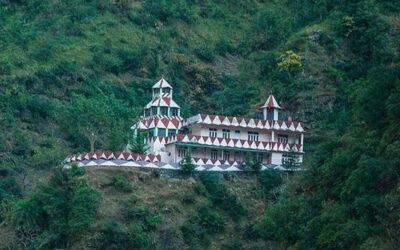Where Radha-Krishna shine in white, and devotion echoes through stone and snow
Set in the serene village of Baroh, about 23 km from Kangra and 45 km from Dharamshala, the Baba Baroh Temple is a modern marvel of white marble, dedicated primarily to Lord Krishna and Radha, with shrines to Durga, Shiva, Hanuman, and Sai Baba. Built in the 1980s by B.R. Sharma, a devout follower of Lord Shiva, this temple is renowned for using more white marble than any other temple in Himachal Pradesh, making it a spiritual and architectural landmark.
🌄 Location & Accessibility
- Location: Baroh Village, Kangra District, Himachal Pradesh – 176054
- By Road: 23 km from Kangra, 52 km from Dharamshala, 12 km from Ranital
- By Rail: Kangra Mandir Station (~17 km), Pathankot Junction (~85 km)
- By Air: Gaggal Airport (~45 km)
- On Foot: A short walk from the Baroh bus stand through mango groves and village lanes
🕉️ Deities & Worship
The temple is primarily dedicated to:
- Lord Krishna and Radha: Enshrined in the main sanctum, carved from pure white marble
- Goddess Durga: A striking metal idol housed on the upper floor
- Lord Shiva, Hanuman, and Sai Baba: Worshipped in adjacent shrines within the complex
Devotees offer flowers, sweets, red cloth, and ghee lamps, and the temple is especially visited during Janmashtami, Navratri, and Deepavali.
🏛️ Architecture & Setting
The temple is a two-storey marble structure, blending modern design with South Indian influences, featuring:
- White marble walls, floors, and pillars, glowing in sunlight and moonlight alike
- A dual-level sanctum—Radha-Krishna on the lower floor, Durga on the upper
- A massive Hanuman idol in the courtyard
- A langar hall, cow shelter, and community service areas
- Panoramic views of the Dhauladhar range, especially stunning at sunrise and sunset
The temple’s clean lines, spiritual serenity, and snow-capped backdrop make it a favorite for pilgrims, photographers, and seekers of peace.
📜 Cultural & Community Significance
- Built by B.R. Sharma, a local philanthropist and devotee of Shiva, in the 1980s
- The temple is named after Baba Baroh, a saint who once meditated in the region
- It serves as a hub for social welfare, offering free meals, shelter for cows, and festive bhandaras during major Hindu festivals
- The temple is a spiritual anchor for the rural population, drawing visitors from across Kangra and beyond
🎉 Festivals & Celebrations
- Janmashtami: Celebrated with bhajans, Krishna leelas, and midnight aarti
- Navratri: Marked by Durga Saptashati recitations, aartis, and community feasts
- Deepavali & Basant Panchami: The temple glows with decorative lights and floral rangolis
- Daily Worship: Morning and evening aartis, incense offerings, and chanting of Krishna and Durga hymns
🏞️ Nearby Attractions
- Brajeshwari Devi Temple: A Shaktipeeth in Kangra town
- Masroor Rock Cut Temples: The Himalayan Ellora carved in stone
- Chamunda Devi Temple: A riverside shrine of fierce grace
- Garli & Pragpur: Heritage villages with colonial charm and cobbled lanes
🙏 Spiritual Experience
The Baba Baroh Temple is not just a shrine—it is a marble hymn, a place where Radha’s grace and Krishna’s smile shine through stone, and the goddess watches from above in silence and strength. As you walk its cool marble corridors, with the Dhauladhars rising behind and the scent of incense in the air, you feel the presence of a divine family that listens, blesses, and embraces. It is a temple where devotion gleams, and the **soul finds its reflection in white stone and golden light.




